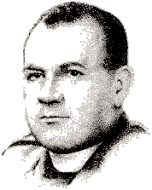Remembrance Day 2012
 Acting Sub lieutenant Nalae Yang and Master Seaman Chris Leger presented Remembrances on behalf of our proud Canadian Armed Forces.
Acting Sub lieutenant Nalae Yang and Master Seaman Chris Leger presented Remembrances on behalf of our proud Canadian Armed Forces.
On this week’s program we were most fortunate to have our own Veteran Jim Warr reading our invocation
Then, as our program Jack Jeffrey reminisced about Canada’s involvement in World War I. He talked about the horrible loss of death inflicted on both sides, accelerated by the then new killing technologies such as the machine guns and chemical warfare.
Jack reminisced about an American Poet, Alan Seeger and quoted from memory his famous World War I poem “A Rendezvous with death.”
“I have a rendezvous with Death
At some disputed barricade,
When Spring comes back with rustling shade
And apple-blossoms fill the air—
I have a rendezvous with Death
When Spring brings back blue days and fair.
It may be he shall take my hand
And lead me into his dark land
And close my eyes and quench my breath—
It may be I shall pass him still.
I have a rendezvous with Death
On some scarred slope of battered hill,
When Spring comes round again this year
And the first meadow-flowers appear.
God knows 'twere better to be deep
Pillowed in silk and scented down,
Where love throbs out in blissful sleep,
Pulse nigh to pulse, and breath to breath,
Where hushed awakenings are dear . . .
But I've a rendezvous with Death
At midnight in some flaming town,
When Spring trips north again this year,
And I to my pledged word am true,
I shall not fail that rendezvous”
(Alan Seeger)
Then Laurie Hurst, introduced Acting Sub lieutenant Nalae Yang and Master Seaman Chris Leger.
Sub lieutenant Yang and Master Seaman Leger honored members of our Canadian Armed Forces over the years from World War I, World War II , the Korean War, The Balkan conflict, Afghanistan and the many peace keeping missions. in which Canada has been involved.
The members spoke about the endeavors of such heroes as:
Captain Ashley Collette;
Captain Collette received the medal as a result of her 2010 deployment to Afghanistan. As a platoon commander from May to December 2010, Captain Collette demonstrated front line leadership that was critical to her soldiers’ success during intense combat in Afghanistan.
Stationed in volatile Nakhonay, her platoon regularly faced the threat posed by improvised explosive devices, all while repelling numerous attacks on their base.
Despite suffering casualties within the group, she kept her soldiers focused and battle-ready. Her fortitude under fire and performance in combat were critical to defeating the enemy and disrupting all insurgent attempts to reoccupy this key village.
Master Seaman Leger honored the memory of Rev John Weir Foote V.C
Of all of the VC stories, the story of Rev John weir Foote stands out. His was not a combat role. He was not trying to stop or advance or take a position. His was a role of compassion.
Foote was born in Madoc, Ontario, May 1904. He attended the University of Western Ontario, London; Queen's University, Kingston; and McGill University, Montréal . He entered the Presbyterian Ministry, serving congregations in Fort-Coulonge, Québec and Port Hope, Ontario. In December 1939 he enlisted in the Canadian Chaplin Services and was posted to the Royal Hamilton Light Infantry. Following the action described in the citation below, Foote was taken prisoner and was not released until May 5, 1945.
|
At Dieppe on 19th August 1942, Honourary Captain Foote, Canadian Chaplain Services, was Regimental Chaplain with the Royal Hamilton Light Infantry. Upon landing on the beach under heavy fire he attached himself to the Regimental Aid Post which had been set up in a slight depression on the beach, but which was only sufficient to give cover to men lying down. During the subsequent period of approximately eight hours, while the action continued, this officer not only assisted the Regimental Medical Officer in ministering to the wounded in the Regimental Aid Post, but time and again left this shelter to inject morphine, give first-aid and carry wounded personnel from the open beach to the Regimental Aid Post. On these occasions, with utter disregard for his personal safety, Honourary Captain Foote exposed himself to an inferno of fire and saved many lives by his gallant efforts. During the action, as the tide went out, the Regimental Aid Post was moved to the shelter of a stranded landing craft. Honourary Captain Foote continued tirelessly and courageously to carry wounded men from the exposed beach to the cover of the landing craft. He also removed wounded from inside the landing craft when ammunition had been set on fire by enemy shells. When landing craft appeared he carried wounded from the Regimental Aid Post to the landing craft through heavy fire. On several occasions this officer had the opportunity to embark but returned to the beach as his chief concern was the care and evacuation of the wounded. He refused a final opportunity to leave the shore, choosing to suffer the fate of the men he had ministered to for over three years. Honourary Captain Foote personally saved many lives by his efforts and his example inspired all around him. Those who observed him state that the calmness of this heroic officer as he walked about, collecting the wounded on the fire-swept beach will never be forgotten. |
Sub lieutenant Yang honored the memory of Andrew Mynarski
In 1940, Mynarski joined the Royal Winnipeg Rifles, a militia unit, but only served a short time before enlisting in the Royal Canadian Air Force (RCAF). In September, 1941, he was posted to No. 3 Manning Depot in Edmonton. After basic training, he went to No. 2 Wireless School in Calgary but had trouble learning Morse Code. He was then posted to No. 3 Bomb and Gunnery School at MacDonald, Manitoba, graduating just before Christmas as an air-gunner, earning his "AG" brevet.[2]
Mynarski was promoted to temporary Sergeant in Halifax just prior to going overseas in January 1942. After a series of transfers through operational training units, as a Warrant Officer (second class), he joined Flying Officer Art de Breyne's crew as the mid-upper gunner in 419 "Moose" Squadron, based at RAF Middleton St. George, Yorkshire.[2]
The squadron first flew combat operations using Vickers Wellington bombers before converting to the Handley Page Halifax bombers. After a short introduction to this four-engine heavy bomber, 419 Squadron began to receive the Avro Lancaster bomber in 1944, including examples built in Canada by the Victory Aircraft Company in Malton, Ontario. In early June, de Bryne's crew received Canadian-built Avro Lancaster Mk X bomber, #KB726, coded "VR-A" (call sign A for Able).[3]
In the aftermath of D-Day attacks on 12 June 1944, Mynarski was aboard VR-A, taking part in the crew's 13th operation, a raid on northern France. They reached their target at midnight, Tuesday 13 June. After encountering flak over the coastline and briefly being "coned" by searchlights, the Lancaster was attacked by a Junkers Ju 88 enemy night fighter over Cambrai, France. Raked by cannon fire with major strikes on the port engines and centre fuselage, a hydraulic fire engulfed the bomber. Losing both port engines, de Breyne ordered the crew to bail out. As Mynarski approached the rear escape door, he saw through the inferno in the rear, that tail gunner Pilot Officer Pat Brophy was trapped in his turret. The tail turret had been jammed part way through its rotation to the escape position.[4]
Without hesitation, Mynarski made his way through the flames to Brophy's assistance. All his efforts were in vain, initially using a fire axe to try to pry open the doors before finally resorting to beating at the turret with his hands. With Mynarski's flight suit and parachute on fire, Brophy eventually waved him away. Mynarski crawled back through the hydraulic fire, returned to the rear door where he paused and saluted. He then reputedly said "Good night, sir," his familiar nightly sign-off to his friend, and jumped.[5]
Except for Brophy, all crew members of the Lancaster managed to escape the burning bomber. Five left through the front escape hatch on the floor of the cockpit. When bomb aimer Jack Friday, tried to release the escape hatch cover in the aircraft's nose, the rushing wind ripped it from his hands. The hatch cover caught him above his left eye and knocked him out. He fell into the open hatch and jammed it closed until Flight engineer Roy Vigars reached him to quickly clip on Friday's parachute and toss him out the hatch while pulling the unconscious crewman's rip cord. Only Mynarski managed to leave via the rear escape door.[6]
Mynarski's descent was rapid due to the burnt parachute and shroud lines, resulting in a heavy impact on landing. He landed alive though severely burned, with his clothes still on fire. French farmers who spotted the flaming bomber found him and took him to a German field hospital but he died shortly afterwards of severe burns. He was buried in a local cemetery. Brophy remained trapped in the bomber and remained with the bomber when it crashed in a farm field. As the bomber disintegrated, and began breaking apart, Brophy survived the crash and the subsequent detonation of the bomb load. Still lodged in his turret, the crash broke the turret open with him pitched out, striking a tree and being temporarily knocked out.[7]
Four of the crew members: Brophy, navigator Robert Bodie, radio operator James Kelly and pilot de Breyne were hidden by the French and, except for Brophy, returned to England shortly after the crash. Vigars remained with the unconscious Friday and both were captured by the Germans, being interned until liberated by American troops. Brophy joined French Resistance fighters and, after joining a resistance unit to continue the fight on the ground behind enemy lines, returned to London in September 1944, where he learned of Mynarski's death. It was not until 1945 when Brophy was reunited with the rest of the crew that the details of his final moments on the aircraft were revealed. He related the story of the valiant efforts made by Mynarski to save him.[8]
Mynarski's grave/memorial (British Plot. Grave 20. Headstone) is at Meharicourt Communal Cemetery Extension near Cambrai, France.
Master Seaman Leger then honored the memory of a more recent hero
Sgt. Janick Gilbert was a search and rescue technician with the 424 Transport and Rescue Squadron based in Trenton.’
Sgt. Janick Gilbert, 34, of Baie-Comeau died outside the Nunavut hamlet of Igloolik Thursday after parachuting into rough and cold arctic waters. He was trying to rescue a father and son who had been stranded in a boat.
Tom Martin; himself a proud Canadian veteran who had served with the “Queen’s Own rifles” thanked our speakers on behalf of the club and gave our speakers a certificate of the gift of eyesight.